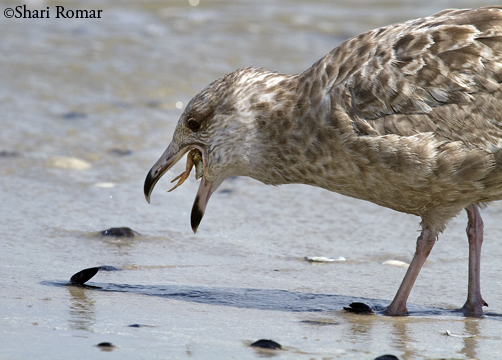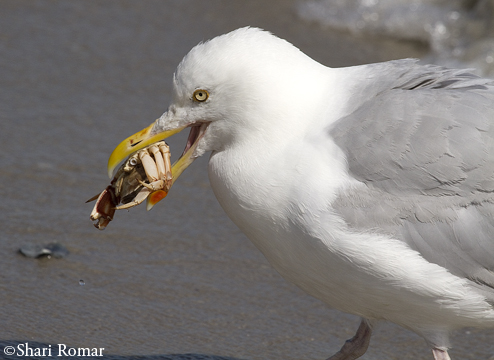Remains of the Day
Hurricane Irene is now past and as I sit in my apartment, I'm wondering how things look about 12 miles away in the Arverne section of the Rockaways.
Just a few days ago, I stopped by to visit the peeps once again but the tide was still a bit high and they had not yet arrived. The surf was a little rough (early signs of the hurricane, perhaps?) and I was intrigued by the large numbers of shells and remnants of crabs.
Investigating further, I started to notice differences in the crab shells, and my attention was drawn to the gulls (primarily Herring and Great Black-backed) that were busy gathering a seafood lunch. Watching them and snapping photos, I was introduced to a bevy of sealife!
One gull was gulping down an Atlantic Starfish, Asterias forbesi, the most common starfish species in the Atlantic. I've seen starfish on childhood Florida vacations, but never realized they were found this far north. How wrong I was! Their range extends as far north as the Gulf of Maine. A seashore favorite, starfish are common shallow water residents and particularly like being close to rocks and oyster, clam or mussel beds (their favorite food).
Given their tough skin, starfish are not frequently preyed upon. I never knew if this gull was able to choke this one down -- he flew away, possibly to deal with the meal in private.
Another popular item on the day's menu turned out to be Blue Crab, Callinectes sapidus. Found along the Atlantic Coast, I generally associate this species with the Chesapeake Bay and other southern waters, but the gulls proved my assumption wrong as they plucked the crabs from the surf. Blue Crabs sport bright blue coloring across their front and claws, fading to an overall olive brown along the shell and legs.
As a bottom dweller, Blue Crabs eat oysters, clams, mussels and also scavenge for detritus. That scavenger title hardly makes them less appealing -- they are quite a popular dish and though they don't have any special conservation status, there is concern about population declines in certain areas, like the Chesapeake.
Females mate just once in their lives and, when carrying 2-8 million eggs on their abdomen, they are nicknamed "sponge crabs." (Note the bright orange appendage on this female that explains the alternate name.)
Kicking around the beach, I came upon the carapaces (like the "top shell" on a crab's body) of what I later determined to be two different species.
Lady Crabs, Ovalipes ocellatus, range from Canada to Georgia, and like many of their relatives, feed on mollusks. They are not demure but rather assertive -- happy to pinch the feet of beach goers as we tiptoe in the surf! -- so I wondered if these remains had once been a crab fished out by gulls or simply came to its end rolling about in the rough waves.
With slightly different coloring and shape, carapaces of Atlantic Rock Crab, Cancer irroratus, were also common. A mobile scavenger, they've been granted popularity status by chefs which may eventually affect their conservation status. Seems our taste buds match the gulls' preferences as well.
I was quite surprised to see a fairly intact tail shell of an American Lobster, Homarus americanus, though I did wonder if it might have been discarded after a barbecue rather than washed up on the shore.
A favorite of humans, birds, and -- as I've now learned -- starfish and crabs, the Blue Mussel, Mytilus edulis, is a familiar site along our shoreline, with a range that extends all over the northern Atlantic Ocean. Quite abundant, they don't have any special conservation status, so this American Oystercatcher, looks unconcerned as he pries open the bivalve with his awl-shaped bill.
Not the observations I expected to make this day, but was very content with my new discoveries. As I packed up to leave, the flocks of peeps arrived. I hope they are still there, safe and sound, after the hurricane.














